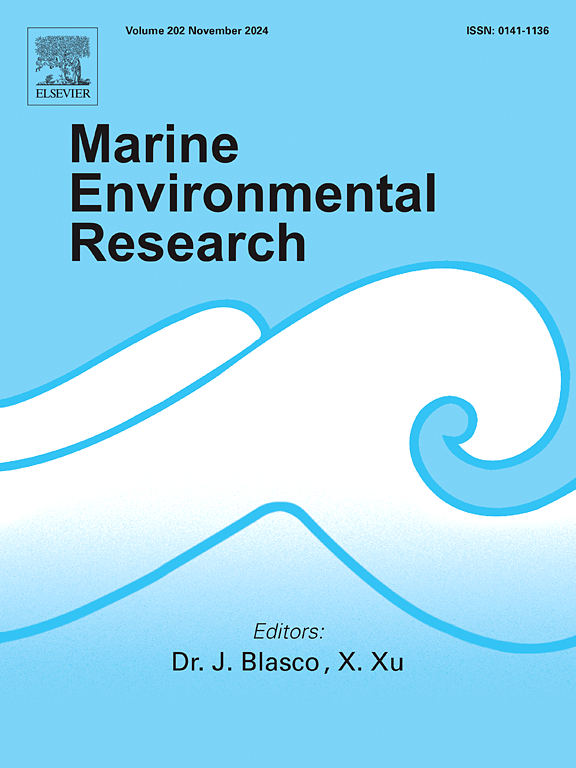Comparative assessment of silver nanoparticle and silver nitrate toxicities in Mytilus galloprovincialis
IF 3
3区 环境科学与生态学
Q2 ENVIRONMENTAL SCIENCES
引用次数: 0
Abstract
Silver nanoparticles (AgNPs) and Ag+ ions are both detected in aquatic environments, posing potential risks to marine ecosystems. Mytilus galloprovincialis is an effective model for monitoring marine environments. In this study, AgNPs were synthesized using a chemical approach, and to distinguish the toxicological effects of AgNPs and AgNO3 in M. galloprovincialis, experiments were conducted using various treatments (control, AgNO3, AgNPs, and AgNPs + cysteine). Our findings revealed that the uptake rate of AgNPs and AgNO3 was different, they predominantly accumulated in the hepatopancreas and gills. qRT-PCR analysis showed varying degrees of alterations in immune genes of HSPA12A, TCTP, sHSP22, sHSP24.1, P63, Bcl-2, and Ras. Histopathological analysis demonstrated disrupted epithelial cell arrangements and connective tissue damage in the hepatopancreas, with the AgNPs exhibiting the most severe damage compared to AgNO3. In addition, AgNPs significantly induced oxidative stress in hemocytes compared to AgNO3, resulting in elevated apoptosis rates. These findings contribute to a deeper understanding of the AgNPs and AgNO3 interactions in marine environments and provide a theoretical basis for the evaluation of marine pollution and biomonitoring strategies.

纳米银和硝酸银对褐贻贝毒性的比较评价
在水生环境中均检测到银纳米粒子(AgNPs)和银+离子,对海洋生态系统构成潜在风险。紫贻贝是监测海洋环境的有效模型。本研究采用化学方法合成AgNPs,为区分AgNPs和AgNO3对牛毛霉的毒理学作用,采用不同处理(对照、AgNO3、AgNPs和AgNPs +半胱氨酸)进行实验。我们的研究结果表明,AgNPs和AgNO3的摄取速率不同,它们主要积聚在肝胰腺和鳃中。qRT-PCR分析显示,HSPA12A、TCTP、sHSP22、sHSP24.1、P63、Bcl-2、Ras等免疫基因发生了不同程度的改变。组织病理学分析显示肝胰腺上皮细胞排列紊乱和结缔组织损伤,与AgNO3相比,AgNPs表现出最严重的损伤。此外,与AgNO3相比,AgNPs显著诱导血细胞氧化应激,导致细胞凋亡率升高。这些发现有助于深入了解AgNPs和AgNO3在海洋环境中的相互作用,并为海洋污染评价和生物监测策略提供理论依据。
本文章由计算机程序翻译,如有差异,请以英文原文为准。
求助全文
约1分钟内获得全文
求助全文
来源期刊

Marine environmental research
环境科学-毒理学
CiteScore
5.90
自引率
3.00%
发文量
217
审稿时长
46 days
期刊介绍:
Marine Environmental Research publishes original research papers on chemical, physical, and biological interactions in the oceans and coastal waters. The journal serves as a forum for new information on biology, chemistry, and toxicology and syntheses that advance understanding of marine environmental processes.
Submission of multidisciplinary studies is encouraged. Studies that utilize experimental approaches to clarify the roles of anthropogenic and natural causes of changes in marine ecosystems are especially welcome, as are those studies that represent new developments of a theoretical or conceptual aspect of marine science. All papers published in this journal are reviewed by qualified peers prior to acceptance and publication. Examples of topics considered to be appropriate for the journal include, but are not limited to, the following:
– The extent, persistence, and consequences of change and the recovery from such change in natural marine systems
– The biochemical, physiological, and ecological consequences of contaminants to marine organisms and ecosystems
– The biogeochemistry of naturally occurring and anthropogenic substances
– Models that describe and predict the above processes
– Monitoring studies, to the extent that their results provide new information on functional processes
– Methodological papers describing improved quantitative techniques for the marine sciences.
 求助内容:
求助内容: 应助结果提醒方式:
应助结果提醒方式:


